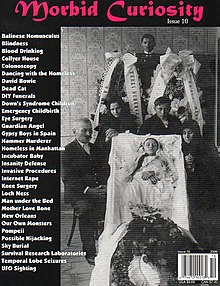
Goth is a subculture that began in the United Kingdom during the early 1980s. It was developed by fans of Gothic rock, an offshoot of the post-punk music genre. The name Goth was derived directly from the genre. Notable post-punk artists who presaged the Gothic rock genre and helped develop and shape the subculture includes: Siouxsie and the Banshees, Bauhaus, the Cure, and Joy Division.
Death rock is a rock music subgenre incorporating horror elements and gothic theatrics. It emerged from punk rock on the West Coast of the United States in the early 1980s and overlaps with the gothic rock and horror punk genres. Notable death rock acts include Christian Death, Kommunity FK, 45 Grave, Zombina and the Skeletones, and Super Heroines.

Gothic fashion is a clothing style marked by dark, mysterious, antiquated, homogenous, and often genderless features. It is worn by members of the Goth subculture. Dress, typical gothic fashion includes dyed black hair, exotic hairstyles, dark lipstick and dark clothing. Both male and female goths can wear dark eyeliner, dark nail polish and lipstick - most often black, dramatic makeup and sometimes fishnets. Male goths use cosmetics at a higher rate than other men. Styles are often borrowed from the punk fashion Victorians and Elizabethans. Goth fashion is sometimes confused with heavy metal fashion and emo fashion.

Hugh Barnett Cave was an American writer of various genres, perhaps best remembered for his works of horror, weird menace and science fiction. Cave was one of the most prolific contributors to pulp magazines of the 1920s and '30s, selling an estimated 800 stories not only in the aforementioned genres but also in western, fantasy, adventure, crime, romance and non-fiction. He used a variety of pen names, notably Justin Case under which name he created the antihero The Eel. A war correspondent during World War II, Cave afterwards settled in Jamaica where he owned and managed a coffee plantation and continued his writing career, now specializing in novels as well as fiction and non-fiction sales to mainstream magazines.

Karl Edward Wagner was an American writer, poet, editor, and publisher of horror, science fiction, and heroic fantasy, who was born in Knoxville, Tennessee and originally trained as a psychiatrist. He wrote numerous dark fantasy and horror stories. As an editor, he created a three-volume set of Robert E. Howard's Conan the Barbarian fiction restored to its original form as written, and edited the long-running and genre-defining The Year's Best Horror Stories series for DAW Books. His Carcosa publishing company issued four volumes of the best stories by some of the major authors of the so-called Golden Age pulp magazines. He is possibly best known for his creation of a series of stories featuring the character Kane, the Mystic Swordsman.

Fangoria is an internationally distributed American horror film fan magazine, in publication since 1979. It is published four times a year by Fangoria Publishing, LLC and is edited by Phil Nobile Jr.

SFX, so called after the common homophonic abbreviation "SFX", standing for "special effects", is a British magazine covering the topics of science fiction and fantasy.

Jill Tracy is a composer, singer, pianist, storyteller and "musical evocateur" based in San Francisco.
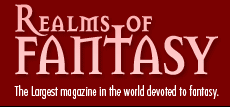
Realms of Fantasy was a professional bimonthly fantasy speculative fiction magazine published by Sovereign Media, then Tir Na Nog Press, and Damnation Books, which specialized in fantasy fiction, related nonfiction and art. The magazine published short stories by some of the genre's most popular and most prominent authors. Its original publisher was Sovereign Media, and it first launched with the October 1994 issue. It was headquartered in Herndon, Virginia.

Terrorizer was an extreme music magazine published by Dark Arts Ltd. in the United Kingdom. It was released every four weeks with thirteen issues a year and featured a "Fear Candy" covermount CD, a twice yearly "Fear Candy Unsigned" CD, and a double-sided poster.

T. M. Gray is an American horror author of many short stories, several novels and a nonfiction book on ghost hunting. Gray lives in Birch Harbor, Maine and is a member of the Horror Writers Association.
Death Equinox was a series of four conventions held in Denver, Colorado in the late 1990s and early 2000s. Sponsored by CyberPsychos AOD, and organized by Jasmine Sailing, they focused on alternative culture and art. A usual aspect was that they combined both the transgressive aspects of writing and art with the actual practice of things that would appear in such works. Convention events included standards such as readings and panels but also featured live concerts, play piercing demonstrations, torture readings and Cnidarian sermons. Rev. Ivan Stang hosted a Church of the SubGenius devival at the second Death Equinox convention.
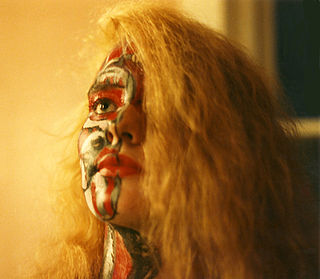
Jasmine Sailing is an author, events organizer, performer, music journalist, and editor-publisher of the magazine CyberPsychos AOD. She also organized the Death Equinox conventions in Denver, Colorado, where she resides. She debuted the CPAOD Books book line in 1995.
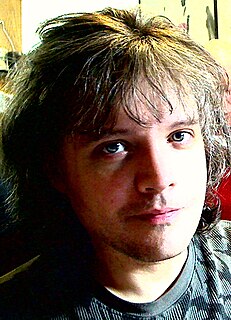
Jason V. Brock is an American author, artist, editor and filmmaker.
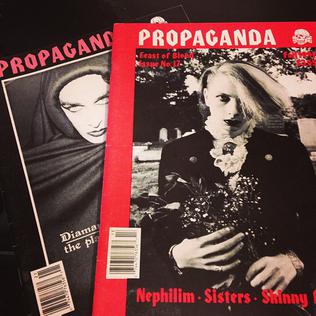
Propaganda was an American gothic subculture magazine. It was founded in 1982 by Fred H. Berger, a photographer from New York City. Berger's photography was featured prominently in the magazine. Propaganda focused on all aspects of the goth culture, including fashion, sexuality, music, art and literature. Propaganda was, at the time of its final issue in 2002, the longest running and most popular gothic subculture magazine in the United States.
Drummer is an American magazine which focuses on "leathersex, leatherwear, leather and rubber gear, S&M, bondage and discipline, erotic styles and techniques." The magazine was launched in 1975 and ceased publication in April 1999 with issue 214, but was relaunched 20 years later by new publisher Jack MacCullum with editor Mike Miksche.

Wednesday Mourning works primarily in the fields of acting and alternative modeling. She specializes in the Goth subculture and has been influential in goth fashion, as well as being the celebrity spokesmodel for Atelier Gothique and appearing as a model for the band My Chemical Romance's CD Welcome To The Black Parade. She was awarded 2010 Goth Day Model of the year and LA Weekly’s Goth Girl of the Week, and since 2012, Mourning has been a co-star on Oddities: San Francisco, a Science Channel program. Mourning is also curator of an esoteric bookstore, Orphic Vellum Books, the only one of its kind in the U.S. She has appeared in several publications including Gothic Beauty and Elle Magazine and is a writing contributor for Celtic Family Magazine.
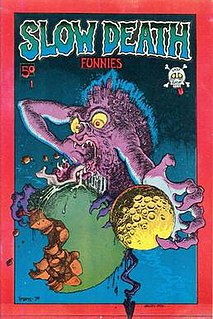
Slow Death is an underground comix anthology published by Last Gasp, the first title published by the San Francisco Bay Area-based press. Conceived as an ecologically themed comics magazine, the title's "underlying theme was always about what the human race was doing to damage the native planet." Frequent contributors to Slow Death included Greg Irons, Jaxon, Dave Sheridan, Richard Corben, Jim Osborne, Tom Veitch, and Dennis Ellefson. Released sporadically from 1970 to 1992, 11 issues were published in all.
Morbid Curiosity may refer to:
Loren Rhoads is a San Francisco-based author, editor, and lecturer on cemetery history. She is a member of Horror Writers Association, Science Fiction and Fantasy Writers of America, and the Association for Gravestone Studies.
